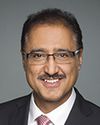Minister, thank you for being here.
I will be concentrating my thoughts and questions on the returns on the investments that we are making, the outcomes, as well as the manner in which we can deliver results based on those investments.
You mentioned earlier that we have the highest economic growth in over 40 years, the lowest unemployment rate, and offsetting costs of local property taxpayers and waste-water rate fares through investments.
What I also see is a theme with respect to the economic, environmental, and social programs through our infrastructure programs, infrastructure strategy, that you have put forward. We have a trade corridor strategy, we have the affordable housing strategy, and the oceans protection plan We have lakes renewal, ports modernization, navigable waters, smart cities, superclusters, and the overall $180-billion infrastructure program that you announced two years ago. This offers equality, safety, security, environmental stewardship, and economic stability.
Mr. Minister, you also mentioned the sustainable funding envelope and the partnerships that you have created. I say “you” because, since 2005 the last Liberal government put in the gas tax as well as—correct me if I'm wrong, Madam Chair—the new deal for cities, and now you've expanded from that by including our partners, the provinces as well as the municipalities, through the strategic plans and their incorporation of community improvement plans.
Going back to my initial comments, in terms of returns and outcomes, what are your thoughts with all that being brought into perspective with all the different ministries working together to achieve those outcomes? What are your thoughts on overall outcomes that you're expecting, not only this year and next year, but 10 years down the road, as these investments are brought into place?





